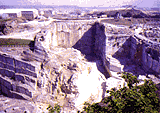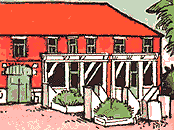|
Quarries
In a landscape dramatically sculpted by enormous
stone quarries, you're looking at how the quarrymen of
Marquise and Rinxent carved their marble out of the rocks in
the hills above Boulogne.
Stone for cathedrals
From here they supplied blocks of stone for many
English and Flemish churches - including St.Augustine's
Abbey in Canterbury. The statue of Napoleon on
top of the Column overlooking Boulogne harbour was carved
from this rock. More recently, thousands of tons of crushed
marble from these quarries was used in making the linings
for the French side of the Channel
Tunnel.
The "Pierre [stone] de Marquise"
(recrystallized calcite from the secondary era) was quarried
by the Romans from
the first century, It is soft and easy to carve and sculpt
but hardens when exposed to air.
The quarrymen of Marquise turned to other types of rock
after the Hundred Years War, when the Pierre de Marquise had
been used up. They dug out hard calcite from the primary era
- called "Marchioness Marble", because when cut and
polished, it looks like marble (but isn't!).
By the 19th century, Marquise stone was in high demand.
There was also a cement works, where local chalk/lime was
burnt using locally mined coal.
The museum
At the "Maison du Marbre" you'll discover not
only how they quarried and shaped the stone in the days of
hand tools before explosives and giant excavators. You'll
learn about the story of 300 million years of geology - how
this "marble", though very hard-wearing and decorative, is
really a hardened form of chalk. You'll see examples of what
craftsmen and artists have made with this special rock.
Fossils
Fossils found by quarry workers help you piece
together clues to how different the environment was when
this rock was formed - when Rinxent echoed to the roar of
volcanoes and dinosaurs...
Walk around the Quarry
Take the trail around the quarry basin which covers 2,500 ha
and discover its almost lunar landscape. Parts of the quarry
are still being used.
|



